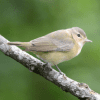 By Jim Stevenson
By Jim Stevenson
First, I am enthusiastically recommending Saturday’s field trip, despite the likelihood of some rain. The precipitation will “down” the birds arriving off the Gulf and could make it quite a good day. We’ll meet at my house at 8 am and quit late afternoon when we can’t look at any more Empidonax flycatchers.
Second, attached is a PDF on vireos, taken as always from recent shots. Later today will be one on flycatchers, their primitive cousins which also have slightly hooked bills.
Lastly, the lady who “manned” the GOS booth at FeatherFest is Anne Bechard, and I would like to publicly thank her for all her hours (days) at the booth. Anne has an opportunity for other women that I find very intriguing and I am pleased to bring it to your attention.
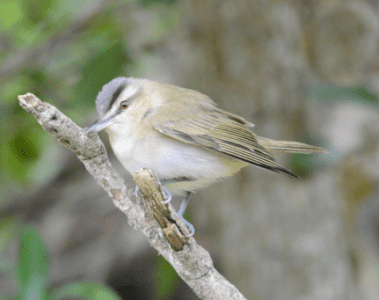
The Red-eyed Vireo probably accounts for at least half the vireos that pass through the Gulf Coast each migration, and is easily identified by the black head stripes. Amazingly, though, this species used to be the most abundant bird in the United States, before the forest fragmentation of the past several decades. It is now apparently the Red-winged Blackbird, owing partly to all the agricultural areas
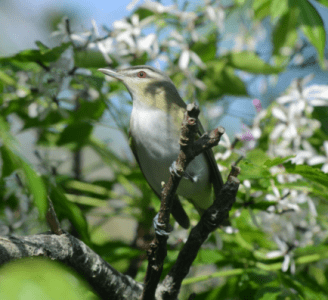
One of the favorite foods of vireos is caterpillars, which they remove from leaves with the use of the hook on their bill tip. This is not unlike that of the flycatchers, although the vireos have a rounder bill, like a cylinder. Flycatchers have a flatter beak which opens very wide when catching flying insects.
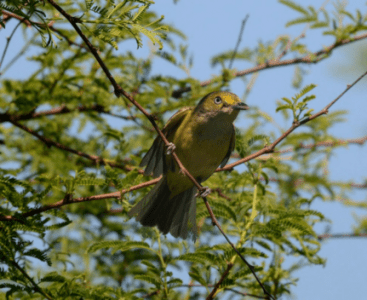
Quite unlike the Red-eyed is the White-eyed Vireo. They are mostly greenish-yellowish- gray with white irises and a very fussy mouth. Their song is actually syncopated, heard all over the brushy, inland regions of the Upper Texas Coast. Like most southern birds they migrate early and are on their breeding grounds by late April.
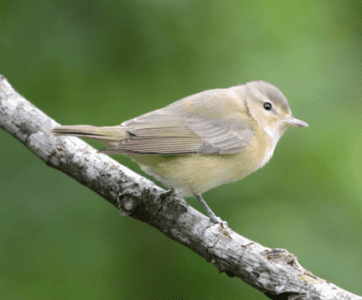
The pale, washed out Warbling Vireo is found over much of the Lower 48, often singing its boring, monotonous song in the tops of trees. In the migration they are much easier to see, although telling them from the Philadelphia Vireo can be a task. On this picture you can again see the tubular, hooked bill so proficient for pulling caterpillars from crevices.
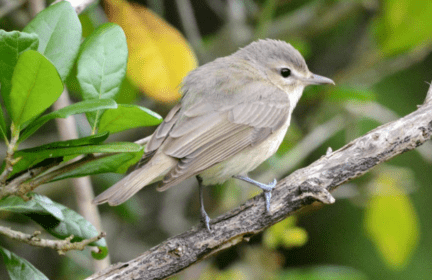
Warbling Vireos are plain gray with a faint supercilium and line through the eye. They are dreadfully similar to the Philadelphia Vireo but generally with more faint markings and little or no yellow. A good way to check your identification is the fact that Warbling migrate early –generally about over by 20 April – and Philadelphia actually begins about that same date (rarely earlier). But these two are tough, so beware!
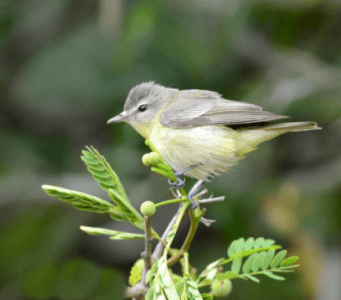
You see what I mean. This is the Philadelphia Vireo, painfully similar to the Warbling. These Phillies are a little yellower on the front and back of their underside and have stronger light and dark markings on their face. The reason Phillies migrate later than Warbling is that they nest further north, and you might want to compare their breeding ranges. This very likely led to their speciation thousands of years ago.
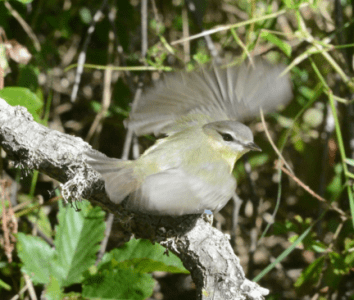
Here you see a Philadelphia Vireo taking off and flashing its wings. It is amazing to me how birds can hold their head and body so still and yet work their wings like the steady machines they are. And remember, these birds fly across the Gulf of Mexico from late afternoon one day to noon or so the next. That would be 600 miles from the Yucatan, 900 from Venezuela and some species 1200 from the West Indies.
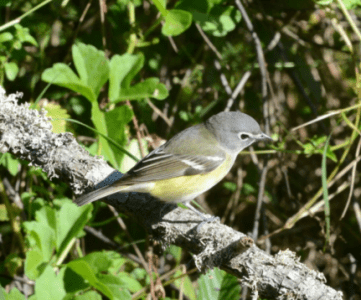
This bird used to be called the Solitary Vireo (for reasons of which I have never really understood) but has now been split into three species. Our eastern bird is the Blue-headed Vireo, and it certainly does have a head. Not sure about the blue. This species is largely a winter resident in the Deep South but a few that winter south of here (in the Tropics) do pass through in spring.
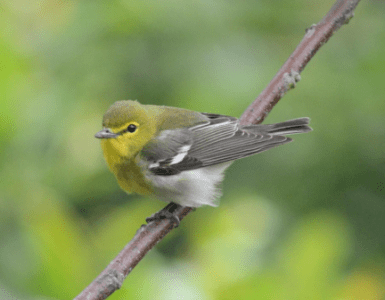
The last of the regularly-occurring vireos is the Yellow-throated Vireo, a breeder in the deep forests of Eastern North America. They are perhaps the most colorful vireo but have the roughest call, a descending scold occasionally matched by the previous species. This bird breeds as close as the Big Val, er, Thicket, along with quite a number of southern nesters. Any hike through the forests of the Big Thicket from late April through most of June will yield this species, as well as the first two vireos mentioned. Vireos have been moved in the phylagenetic order near to the most primitive songbirds, showing their possible relation to the flycatchers who share their slightly hooked bill. I believe they are strictly a New World phenomenon.

 Posted in
Posted in 
























